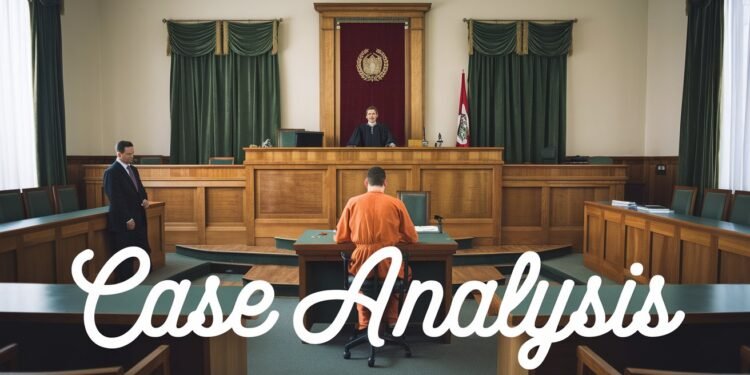Author Shaan Marvaniya from Gujarat National Law University
Facts:
In this case, Sweety, a young B.Com 2nd year student, died under mysterious circumstances 15 days after her marriage. Sweety married Babu, a post-graduate employed in the Gulf at Alukkas Jewellery, on 15.5.2000. They spent a few days at various locations, including the homes of Babu’s brother and a friend named Benny (PW.10). They spent two days at Ollur and then returned to Sweety’s home in Chalakudy. On 19.5.2000, they went to Kozhikode to visit Benny (PW.10), returning on 22.5.2000. Sweety took her B.Com 2nd-year exam on 23.5.2000. Babu stayed with his brother at Ollur on 26th/27th May, feeling unwell. Sweety’s mother, Omana Poulose (PW.9), visited Babu’s mother’s house on 27.5.2000 to check on her health before her cancer surgery on 30.5.2000. At the insistence of Sweety and her mother, Babu and Sweety attended Benny’s wedding on 31.5.2000 in Kozhikode. After the wedding, Benny’s wife, Seethal, went to her parents’ house due to family issues with the love marriage.
While staying with Benny, Babu stepped out to call his employer after drinking. When he returned, he found Sweety and Benny in a compromising position. Babu confronted Sweety, who claimed Benny had forced himself on her. These details were provided by Babu in his statement under Section 313 Cr.P.C. On 1.6.2000, Babu left Sweety at her parents’ house in Chalakudy to visit his mother at the hospital. When Babu returned to Sweety’s house at 10:30 p.m., he found her room bolted from the interior. After breaking in with her father, they found Sweety oblivious. She was pronounced dead at the Government Clinic, Chalakudy. Sweety’s father recorded an FIR on 2.6.2000, and the examination uncovered cyanide harming as the cause of passing. Babu was captured on 26.6.2000 after it was found he had obtained cyanide without further ado some time recently Sweety’s passing. He supposedly confessed to giving her cyanide camouflaged as an ayurvedic prophylactic. The arraignment claimed Babu killed Sweety, but he contended that Benny (PW.10) had gotten out of hand with Sweety, conceivably driving her to commit suicide out of blame. The trial court vindicated Babu on 8.4.2003, distrusting the prosecution’s witnesses. The matter was taken up by the High Court which overturned the trial court judgement and a further appeal was done by the husband of the deceased in the Supreme Court.
Issues:
The main legal questions raised by the Supreme Court in this appeal were:
- Can an appellate court generally overturn a trial court’s acquittal? This involves examining the conditions under which an appellate court is permitted to reverse an acquittal, considering the relevant legal standards and precedents.
- Was the circumstantial evidence sufficient to prove the accused’s guilt beyond a reasonable doubt? This necessitates assessing whether the presented circumstantial evidence was robust and coherent enough to definitively demonstrate the accused’s involvement in the crime, thus warranting a conviction.
Relevant Laws:
Section 302 of the Indian Penal Code, 19860, and Section 313 of the Code of Criminal Procedure, 1973.
The Indian Penal Code specifies offenses and their corresponding punishments, including those for murder, under Section 302. If a person is found guilty under Section 302, they face severe penalties, such as death or life imprisonment. Notably, the crime of murder is classified as non bailable, cognizable, and exclusively triable by the Court of Sessions. These legal details highlight the seriousness of the crime and the procedural protocols for investigating and adjudicating murder cases.
The different kinds of punishment mentioned in Section 302 include:
- Death Penalty
- Life Imprisonment
- Fine
Section 313 of the Code of Criminal Procedure, 1973, is a key provision that ensures fair trial procedures by allowing the accused to respond to the evidence and circumstances presented against them during the trial. This section grants the accused the opportunity to personally address and explain the incriminating evidence. Rooted in the principle of audi alteram partem, it ensures the accused has a chance to be heard by the court. For this testimony to be effective, the examination must be conducted seriously. The court should thoroughly consider the accused’s explanations to prevent the trial from being compromised by unfounded or irrational defenses.
Appellant’s Arguments:
Shri Venkat Subramonium T.R., counsel for the appellant, said that the High Court should not have regularly overturned the Trial Court’s decision and order of acquittal. He argued that the Trial Court’s judgments, based on the facts presented, could not be considered perverse or irrelevant. The Trial Court, having experienced the prosecution witnesses’ behavior firsthand, correctly questioned their credibility, strengthening the appellant’s innocence.
However, the High Court made a serious error in deciding that the circumstances clearly suggested the appellant’s guilt without considering any evidence that contradicted this judgment. Furthermore, the High Court’s decision to revoke the acquittal and levy a punishment of Rs. 1,00,000/- on the appellant was unwarranted. In this case, the evidence is entirely circumstantial, as no direct evidence exists. Therefore, the prosecution had to demonstrate a motive for the crime. Establishing a case with circumstantial evidence is distinct from doing so with direct evidence. The Trial Court’s decision did not justify any interference, so the appeal is valid and should be upheld.
Respondent’s Arguments:
The state’s knowledgeable attorney, Shri R. Sathish, vigorously objected to the appeal and made the following claims:
He argued that the appellant was the only one who had the chance to carry out the criminal act. This assertion is supported by the evidence, which shows that the accused was able to obtain sodium cyanide and was familiar with its use in purifying and coloring gold jewelry because of their similar work environments. This suggests that he was directly involved in the offense.
Additionally, he contended that the High Court had properly considered the evidence and declared the accused guilty, while the trial court had erred in not believing the prosecution’s witnesses. The appeal before the Apex Court is consequently without merit because this ruling should not be reversed.
Analysis:
In this murder case, the investigation explored the circumstances surrounding the cyanide poisoning of Sweety, Babu’s wife. The prosecution’s case largely relied on circumstantial evidence, alleging that Babu had given Sweety cyanide disguised as an Ayurvedic contraceptive. Despite these claims, the Trial Court acquitted Babu due to inconsistencies and the lack of conclusive evidence directly linking him to the crime. However, the High Court later highlighted circumstantial evidence that suggested Babu was the perpetrator.
In its judgment, the Supreme Court reinstated the lower court’s verdict, emphasizing that the prosecution had failed to establish a motive for Babu based solely on circumstantial evidence. The Court stressed the necessity of stringent conditions when using circumstantial evidence to prove guilt beyond a reasonable doubt. The absence of a clear motive and the prosecution’s heavy reliance on circumstantial evidence made the case particularly challenging to prove. This case underscores the difficulty of securing convictions based solely on circumstantial evidence and highlights the necessity of maintaining appropriate standards. It reaffirms the principle of “innocent until proven guilty” and emphasizes that the burden of proving guilt lies with the prosecution, a burden that becomes even heavier when circumstantial evidence is involved. The Court underscored the need to consider the probative value of evidence to prevent miscarriages of justice and uphold the rights of a fair trial.
Conclusion:
In its numerous decisions, the Honourable Supreme Court has emphasized that irrefutable proof and a distinct motivation are necessary in order to prosecute someone under Section 302 of the Indian Penal Code for the terrible crime of murder. The aforementioned viewpoint was restated in the 2010 case of Babu v. State of Kerala. The prosecution is ultimately in charge of establishing guilt beyond a reasonable doubt; it is not the accused’s job to disprove their innocence. Granting the accused the benefit of the doubt is mandated under the legal premise of “innocent until proven guilty”.
The prosecution must provide indisputable proof and demonstrate a motivation in order to prosecute someone under Section 302 IPC for a heinous crime like murder. This was stressed by the Supreme Court. Since the accused is always assumed innocent unless and until the prosecution establishes their guilt beyond a reasonable doubt, it is unreasonable to expect them to prove their innocence. The court determined that the prosecution had not shown enough
evidence in this instance. They were unable to provide convincing evidence connecting the accused to the claimed offense. The court decided that a mere suspicion could not lead to a conviction since there was insufficient proof. The court emphasized that the prosecution must provide strong proof connecting the accused to a motivation, particularly when depending on circumstantial evidence, and that basic legal principles demand an assumption of innocence.
The Supreme Court ruled that in order to preserve the fundamental justice principle, there must be an assumption of innocence in favor of the accused in situations based on circumstantial evidence. To guarantee full justice, the burden of proof must be scrupulously adhered to in order to establish guilt beyond a reasonable doubt. When it comes to preserving due process of law, no concessions are acceptable.



